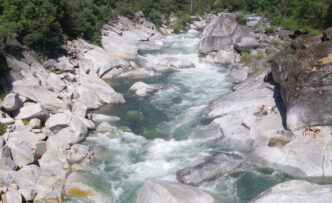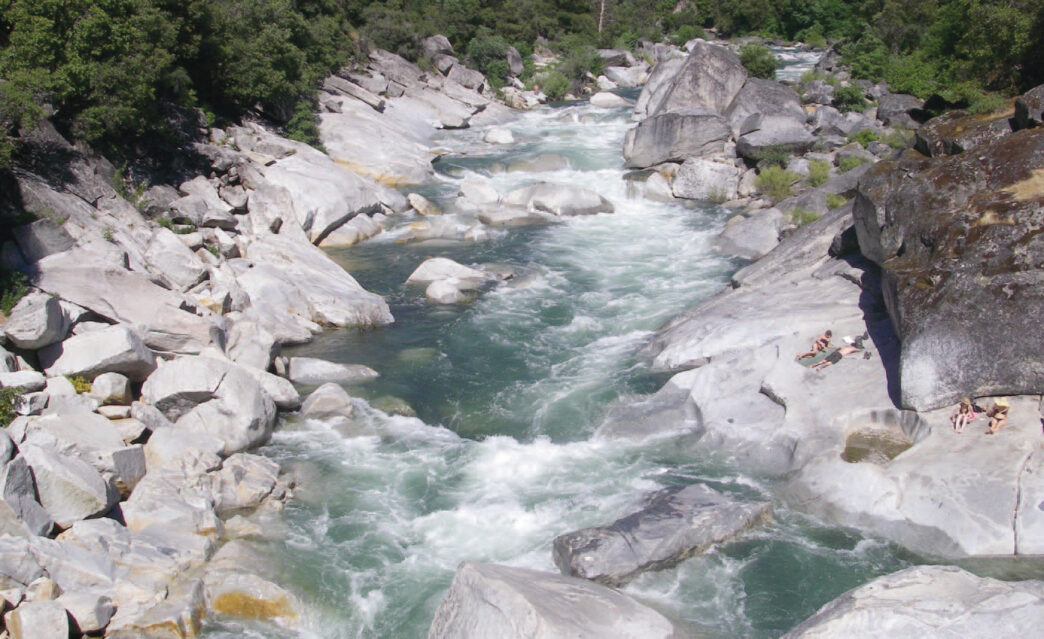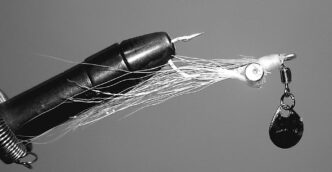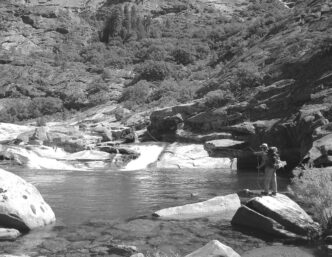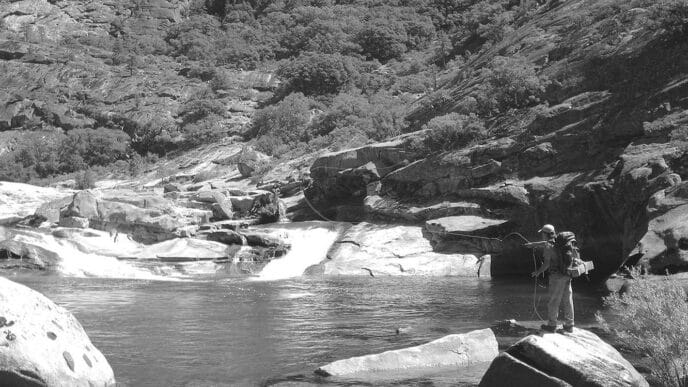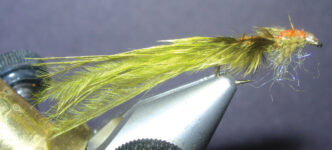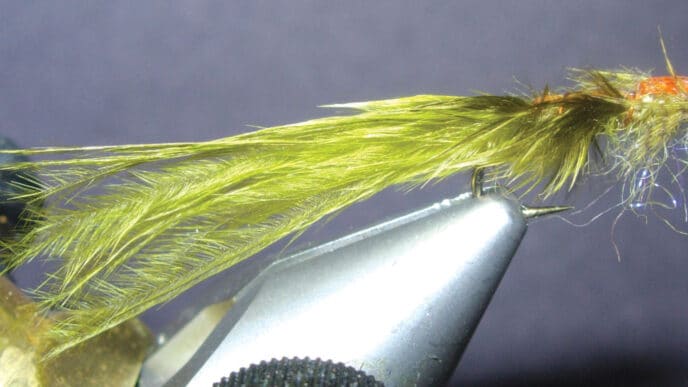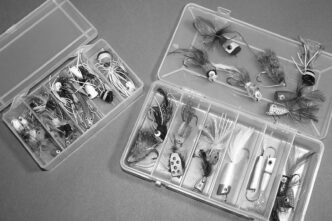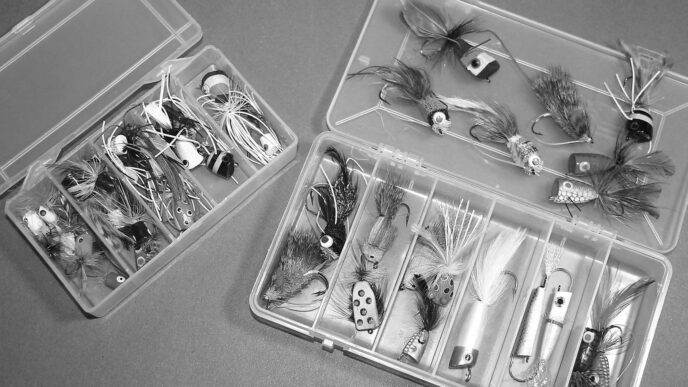At some point in your angling career, you will have to face the fact that you will no longer be able to feel comfortable wading your favorite stream. This loss of confidence and comfort level could be caused by an early knee injury or some other aspect of the aging process that ultimately gets to all of us. Your discomfort might come from physical infirmities, a diminishing sense of balance, a cardiac issue, failing eyesight, or just loss of muscle mass that makes rock hopping in a canyon challenging or impossible. Males lose approximately 5 percent of their muscle mass per decade after age 40, and changes in testosterone/estrogen chemistry affect males and females alike. You don’t see many 60-year-olds climbing Mount Everest, playing basketball, or for that matter wading Pit Number 3 or the Owens Canyon.
There are actions we can take that will prolong our useful fly-fishing lives, and there are good options beyond wading and fishing moving water. I hear lots of young guys say, “I wouldn’t be caught dead on a lake. I love rushing water!” You might want to retract that statement if you no longer could walk very well, and especially if you’d found five-pound rainbows or largemouth bass at the end of your fly rod while float-tubing a local pond.
Let’s look at what we can do to stave off the effects of age and also at what our options are after we feel that aggressive wading is no longer a good idea.
It was a knee injury that got me, and that disability was compounded by a back problem. I was off the river for three years. A successful surgery and some serious physical rehabilitation have me back on the water now, but as Dirty Harry said, “You’ve got to know your limitations.”
Focus on Location
First, pick your spots. Remember the story about the Warden of the Madison: He comes over from Dillon every night and greases the rocks. As we age, we need to wade bottoms composed of sand and small aggregate. Not only do you need to think about places where you can wade with comfort, but you need to anticipate what scrapes you can’t get out of anymore if you get in trouble. You should have an exit strategy before you enter the water. You might have escaped being deep-sixed once or twice in your thirties, but you won’t now that you are fifty, sixty, or seventy. If you make a bad decision or get unlucky, you could be toast. Don’t fish where a fall does more than get you wet.
I fish the lower Yuba all season, but particularly in the winter. A birthday present this spring was a personal floatation belt that is worn with my waders in addition to wading belt placed higher up. It doesn’t hinder me in any way. Even with this belt, I’m a lot more careful than I was 10, 20, or 30 years ago.
I go back to a lesson from André Puyans 35 years ago. Andy contracted polio as a child in Batista’s Cuba. He carried physical limitations with him the rest of his life. That’s one of the reasons he loved the Railroad Ranch in Idaho, Hat Creek, Hot Creek, and the Rising River. These streams are easy to wade. Andy was ponderously methodical, but his slow pace gave him the time to observe the water carefully, spot fish, and find the best lies that held the biggest fish. Angling partner and good friend John Bjorkholm says, “I’ve become a better fisherman now that I pick my spots because of wading limitations, and I’ve become a more astute observer.”
Often you can fish effectively from the bank. Sometimes it’s best not to enter the water at all. Don’t step on the fish!
Don’t just pick your spots, pick your times, as well. With each decade, I find that fishing in prime time is more and more important. Most angling success comes in short windows of opportunity several times each day. I don’t care to be out in the sun and wind from dawn to dusk anymore. If I am rested and fully alert, I can capitalize on those moments of prime time. I can’t begin to tell you how many times a 20-minute window made my angling day. If you’re not sharp and ready when it happens, you lose!
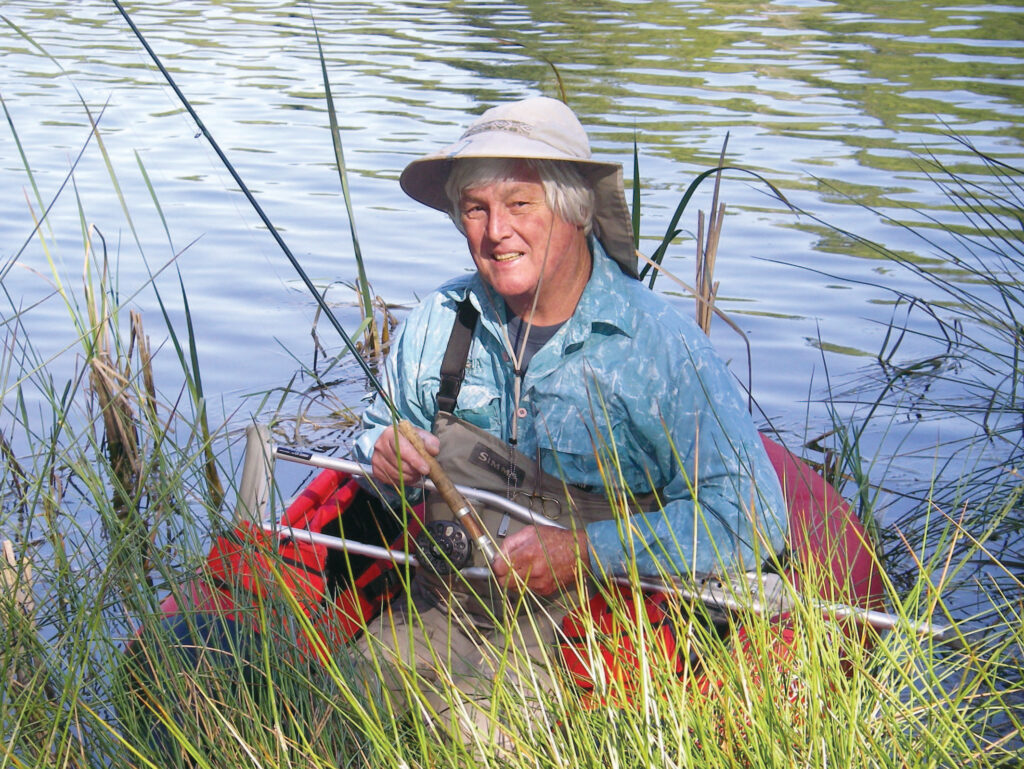
Get in Shape
Exercise tailored to help my angling has become very important. Not only do I target my lower body to build leg strength and agility, but I target my core and upper body so casting will not give me wrist, shoulder, neck, or elbow problems. Four of us traveled to the Bahamas this spring for a week of bonefishing. At my urging, several in our group worked out with light weights and practiced casting with heavier-weight rods for several months before our trip. We picked breezy days to improve our casting in the wind. Even though we dealt with heavy rod and line weights all day long in strong winds for a week, not one of us had any upper-body problems when it was time to return home. Our ages range from the mid-sixties to the mid-seventies. We are already thinking about our next destination.
Exercise can improve your balance, too. Conversations with angling partners and fly-shop operators suggest that one of the biggest problems that older anglers have is loss of balance. I know that it is an issue with me, and I know that agility exercises help improve balance.
Dr. Gina Lokna, head of sports medicine at the U.C. Davis Medical Center in Sacramento, emphasizes that balance comes from more than just strong legs and knees. It involves proprioception, the internal sense we have of the position of our own bodies and limbs. It’s what police officers test for when they pull someone over for driving under the influence. Because proprioception involves the whole body, exercise that helps keeps the whole body toned up therefore becomes important. And exercise is important for keeping your mind pliable and balanced, as well.
At Hot Creek Ranch, the rules and angling etiquette prohibit one from entering the streambed to fish. This is intended to protect the delicate aquatic environment and keep the trout from being stressed, but it is a blessing for those who have difficulty with ambulation. You could fish the stream with a cane or a walker, if you really had the desire . . . and burning passion is indeed important.
While we’re considering balance, don’t be too proud to use a wading staff. In fact, I’ve learned that a wading staff works very well for more things than wading. It is my cane, and, because it’s collapsible, I take it with me when I travel and I use it for a trekking pole. More than once on an overseas trip, I’ve been comforted by the thought that it would also be a great street weapon if I were accosted by pickpockets or muggers. But it’s a great help in getting around rocky river bottoms, too.
Physiological Factors
Altitude is another issue. If you have cardiac limitations or aren’t in the best of shape, the Truckee or Owens at 6,000 feet or high-country backpacking may not be for you. Learn to adjust you pace and take breaks. Even with my orthopedic limitations, I can walk the entire meadow of the Little Truckee if I pack a sandwich and water and take the whole day to make the journey. As I noted above, It’s amazing what you see if you stop for a while on a good piece of water and study it.
Diet and hydration are important for any angler. For seniors on the river, consideration of these two factors should be axiomatic. I have a 30-year-old book in my library that is titled Eat to Win.I bought it for ideas in counseling my dental patients on the importance of eating sensibly and to help me with competitive tennis as I turned 40, then 50, then 60.
The book deals with eating well to enhance athletic performance. A long day on the stream can be as demanding as any day on the athletic field. Dehydration is your enemy. The dry air at higher altitudes enhances dehydration, which saps your strength. Start by hydrating properly the day before. Drink lots of water. Most cramps come because of low hydration levels 24 hours earlier. Moderate your alcohol, caffeine, and nicotine intake so that your electrolyte balance is in order. It’s your intake the day and night before that affects the next day’s well-being. A slug of Gatorade won’t fix last night’s problem instantaneously, but it sure helps if you drink a bottle or two during the course of a day’s activity. Carbohydrates ensure quick energy, but protein at breakfast and at dinner the night before is very important to give you a stable blood sugar level and staying power on a long day. The “angler’s breakfast” of Krispy Kreme doughnuts, high-acid orange juice, and three cups of high-octane coffee won’t win a tennis match and won’t give you the gradual energy release that you need for a day or a whole week of angling. Even young guys fade when that sugar high disappears and there is nothing left in the tank. Don’t forget lunch. You need the energy and the break.
Other Options
You might want to consider engaging a guide to help you with your angling. Perhaps it’s a float on the lower Sacramento in a drift boat or trolling flies with Jay Fair. Sure it’s expensive, but save up and treat yourself. Just let your guide know your limitations. Most are thrilled when they can help someone enjoy the angling experience. Some even take wheelchair anglers.
If you’ve done everything possible to deal with a disability that limits your hiking and wading, but still aren’t comfortable wading streams, try stillwater fly fishing. There are lakes that fish very well from shore. I fish every week with a group of guys and gals who are members of the Gold Country Fly Fishers. We have discovered that float tubes, pontoon boats, and prams can extend our angling lives. There’s a reason legions of fly fishers, women and men, old and young, have adapted their angling methods to float tubes and small watercraft. There is lots of water out there with big fish, and it’s very easy to beat the crowds that drive us from many rivers.
I know young stream anglers who won’t leave their babbling brooks or their backpacks with five-piece rods, freeze-dried food, and Primus stoves, but the solitude of a back cove filled with nymphing trout in the swirling morning mist has its charms, as do multipound trout feasting on blundering carpenter ants. Besides, there are lots of stillwaters out there. There’s a world of still water to challenge, both large and small, high and low, more than the maps show.
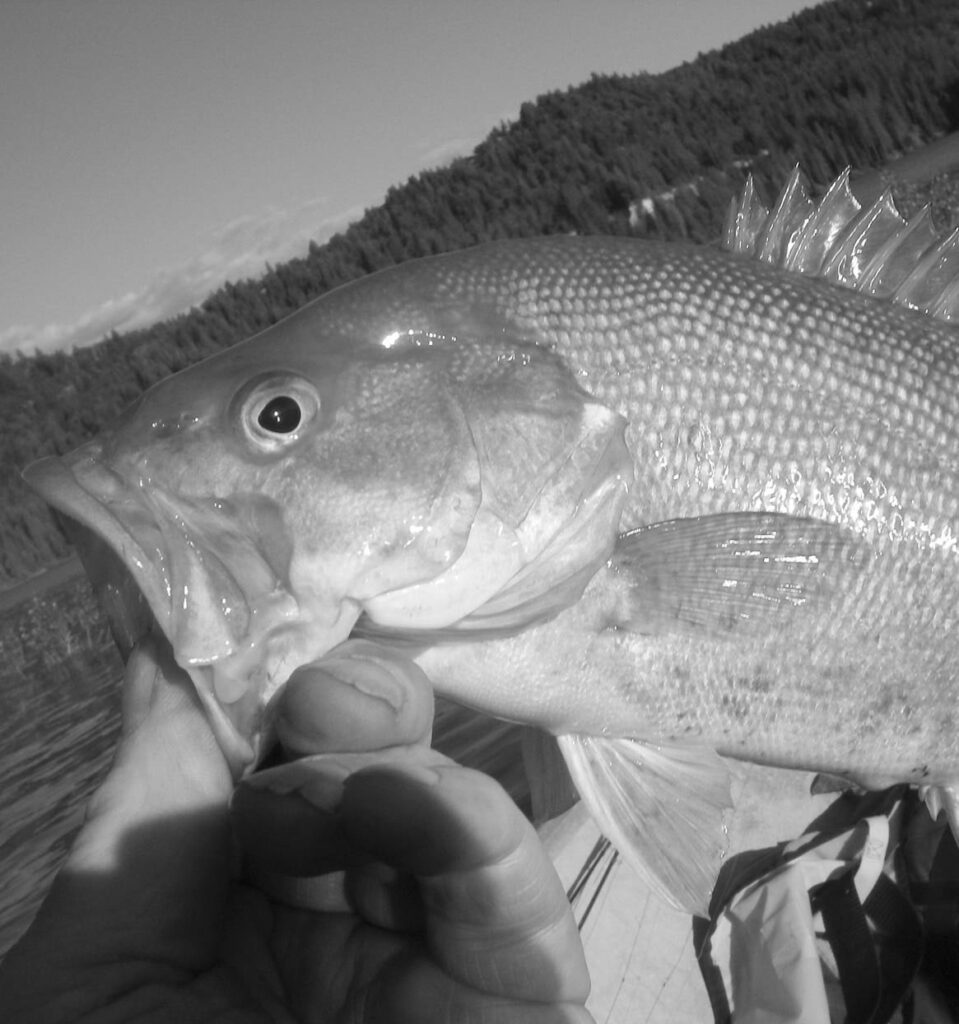
After triple-laminectomy back surgery three years ago, with my doctor’s approval, my first exercise beyond walking was in a float tube. I started with a gentle 15-minute paddle around a neighborhood pond and was up to several hours on a local lake within a month. I can’t tell you how great it was to be on the water, with ducks and fish commiserating with me after most of a month spent indoors. Take something away and you really learn to appreciate it. Leg action propelling my fins tightened my derrière, strengthened my thighs and ankles, and improved my circulation. Casting from a low platform firmed up weakened shoulders, arms, and wrists.
A float tube can be used almost anywhere. It is easily stowed in a vehicle, is relatively inexpensive, and can be carried deflated in a vehicle on a long trip. Remember, though, to partially deflate your float tube as you gain altitude. Even a climb of 2,000 feet can burst a fully inflated tube as the air expands with the lower atmospheric pressure of higher altitude. A loud bang will let you know if you forgot. If you’re a wading angler, you already have breathable waders and need only flippers to complete your outfit. In the summer, you may not even need waders.
Float tubes give aging anglers access to a wide variety of waters and offer a sense of serenity and intimacy with the environment that larger craft lack. Often you get to witness aspects of the natural world that others miss because they are moving too quickly. The stealth provided by a float tube creates a tremendous angling advantage, and there is something about being on the water in a very quiet device that is soothing for the soul.
I’m 68, and I fish with friends who are in their eighties. Even if you can no longer cast, in a float tube, success comes with dragging a line behind a slow kick. It’s a tried and true technique. I find float tubes to be a safe and a therapeutic way of continuing fly fishing, not to mention the fact that we consistently catch bigger fish than those who wade our crowded and overfished rivers.
So don’t quit fishing until you have exhausted your creativity, resources, and determination. Several of my friends are inspirations to me. One lost a lung in World War II and another has two artificial hips and a titanium knee. Yet another fished with an oxygen bottle.
A few months before my dad passed away, we drove up to Fuller Lake, and I cleared sticks and pine cones from a path so we could make it to the water with his walker. I’m not embarrassed to say that we dunked night crawlers for a couple of hours and shared cold pizza left over from the night before. I prayed for a fish to grab that worm and let him catch one more fish, but it wasn’t to be. It didn’t matter. Dad talked all the way home about the great trees and the osprey that he saw across the lake that day. If you’re an angler at heart, you always will be. There are always ways you can keep on fishing, even as age catches up with you.
Consider the Float Tube
The watercraft hasn’t and won’t be made that can do everything or go anywhere. Compromise comes to bear somewhere, but American float tube manufacturers have done a lot of research and have incorporated their findings into their products . . . even if the things are made in China.
Start by not compromising on safety. Low-end merchandise will bring you only grief and cost you money in the long run. In the middle price range and up, you will find some remarkable products that will last for years and years.
Your weight is a huge factor. If you are near the listed capacity rating of a tube, go up a notch in size. If you aren’t going to backpack or will only drag your tube short distances, you can go with a heavier model. A float tube can be used on any lake or pond that you can reach with a four-wheel-drive vehicle. Most have heavy-denier outer shells and some have vinyl shields that protect the ends and bottom from rocks, sticks, and thorns when you drag your tube across beaches and on portages.
The earliest models were truck inner tubes with sewn canvas seats. We thought they were heaven, but they were hard to get into and out of with a pair of flippers attached to your feet. Getting into one was an exercise in agility for a Cirque du Soleil acrobat, and I’ve seen some accidents where anglers fell face first into the water and were helpless. A few years ago, we witnessed a comical and possibly tragic scenario at Lake Davis when two guys high on dope tried to get into their tubes and then back into the lake with their flippers on. As funny as it was, it could have ended in tragedy.
For me, as an aging man, front-end entry as in a U-boat-style float tube is a must. A double air bladder, a floatation seat, and back-rest cushions are mandatory. Sharp fish fins, hooks, and submerged sticks can pop a cell. It’s difficult for that to happen, but it has occurred. Some municipal waters require a personal flotation device (PFD) in addition to the built-in flotation.
Seat height is crucial. Inflatable cushions offer a smaller deflated profile, but can cost a bit more. Several angling buddies add another cushion to get their butts a bit higher out of the water. Every inch helps your vision, but can change your angle of thrust and make it easier to slip off the cushion.
Propulsion is backward, and the thrust angle can influence efficiency a great deal. Short guys probably don’t want to be really high. I splurged last spring and bought a pair of Force Fins after buying and trying three different brands over a number of years. Experiments number 2 and 3 went onto the swap table at our fly club. My new fins give me another 25 percent efficiency, which really helps, because I’m a big guy and have weak legs from my disability nerve loss. They also do the duck walk a bit better on shore. Some don’t like them. How easy is the pair that you select to put on and take off? It can make a big difference. Borrow a pair and try them out before buying, or get an agreement on a merchandise return from your dealer. Does the pair that you select have or need safety straps? It’s tough kicking back to the shore with only one fin.
I like to wear some type of a lightweight boot over my waders’ stocking feet that allows me to walk distances if I have to portage or if the wind leaves me stranded away from my entry spot. It can happen, and a comfortable boot for the walk back is invaluable. The Gold Country Fly fishers recently held a float-tube clinic where members could try different tubes and different fins. Another good source for information is your local fly shop. They know from customer input what works. Your big-box or mail-order palace may not be able to give you the information that helps you make a wise and money-saving decision. Don’t forget to ask your buddies. Many have used different models and know what works best.
For me, breathable waders need to be loose enough so that I can comfortably address the “pee” issue that arises from prolonged minutes on the water. I can’t speak for the gals, but the reality is that you will have the need to get out of the tube every once in a while or find another solution. Where there is a will, there is a way. Small plastic or metal cups, and modified wide mouth plastic water bottles do work!
Most float tubes come with stripping aprons that have a built ruler for measuring your catch. Some have straps to hold one or more rods while you fish, and this can provide a huge advantage. It’s easy to slip, drop, and lose a rod or reel when trying to change a spool, and it’s a plus to be able to switch rods and capitalize ASAP on a changing angling situation. I carry a rod rigged with a floating line as well as a rod rigged with a clear intermediate line. I fabricated a rod carrier out of Velcro straps that use the “D” rings built into a good tube, adding a plastic clip for insurance. An extendable catch-and-release “measure net” tucked in behind my backrest helps with landing fish before lactic acid build-up compromises their recovery. It also tells you reasonably accurately how long your fish was. A jacket and a sandwich in a lightweight dry bag can tuck in behind the backrest, as well. Safety-related items that I bring include a “boating” whistle, an extra air valve, a small flashlight, a pocket knife, a walkie-talkie, a cell phone if there is likely to be a signal, a length of quarter-inch cord, and a water bottle. A float tube is a small watercraft and should be operated with good sense and safety always in mind. Keep an eye on the weather. Ask yourself before you get in, “If the wind comes up, what can I do?” And as time goes by, ask “Is it really a good idea to be this far out?” Stories circulate about anglers who get blown across a lake.
Use good sense if the water is cold. Hypothermia comes quickly and can kill, even in the summer. If the water is cold, say, 41 degrees, think about whether you should really be out there. Pull on your fleece pants, even if your first impression is that you won’t need them.
Think about what will happen if you have an accident. You’re not in a 40-foot yacht. Start out on a small body of water and get your sea legs. Consider fishing with one or more partners. Take breaks on a regular basis to rest your legs and avoid cramping.
I have been tempted to use my float tube in the ocean, but I know that an angler in a float tube with legs dangling underneath looks a lot like a seal. In Northern California, seals are the great white shark’s favorite food. Besides, open-water tides and sudden offshore winds are treacherous and overpowering. It’s a long way across the Big Pond. River running seems intriguing, but currents can trap you against snags or rocks,
and rapids can flip you. Can you walk out of a canyon if a problem rises? Exercise prudence if you perceive even the tiniest risk. Thorough knowledge of a river might not be enough to keep you out of trouble.
Reality is that float tubes are very safe if common sense is used. That’s why insurance rules allow float tubes or pontoon boats and not prams on some lakes.
Trent Pridemore



